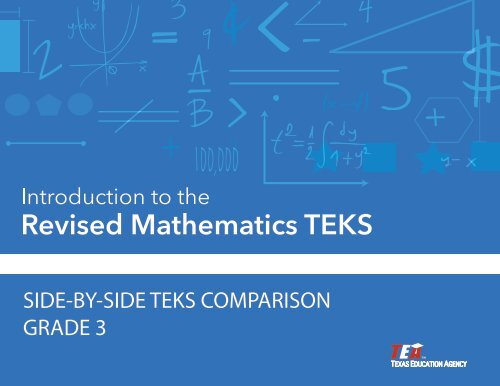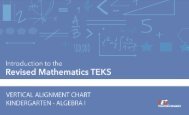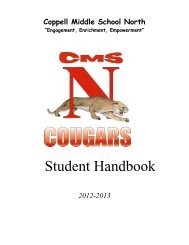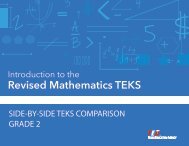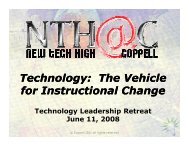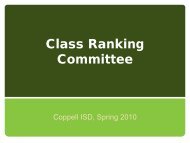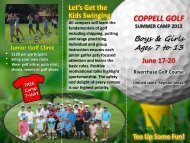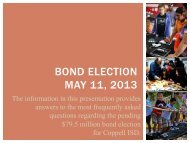SIDE-BY-SIDE TEKS COMPARISON GRADE 3 - Project Share
SIDE-BY-SIDE TEKS COMPARISON GRADE 3 - Project Share
SIDE-BY-SIDE TEKS COMPARISON GRADE 3 - Project Share
Create successful ePaper yourself
Turn your PDF publications into a flip-book with our unique Google optimized e-Paper software.
<strong>SIDE</strong>-<strong>BY</strong>-<strong>SIDE</strong> <strong>TEKS</strong> <strong>COMPARISON</strong><strong>GRADE</strong> 3
The materials are copyrighted (c) and trademarked (tm) as the property of the Texas Education Agency (TEA) and may not be reproducedwithout the express written permission of TEA, except under the following conditions:• Texas public school districts, charter schools, and Education Service Centers may reproduce and use copies of the Materialsand Related Materials for the districts’ and schools’ educational use without obtaining permission from TEA.• Residents of the state of Texas may reproduce and use copies of the Materials and Related Materials for individual personal useonly without obtaining written permission of TEA.• Any portion reproduced must be reproduced in its entirety and remain unedited, unaltered and unchanged in any way.• No monetary charge can be made for the reproduced materials or any document containing them; however, a reasonablecharge to cover only the cost of reproduction and distribution may be charged.Private entities or persons located in Texas that are not Texas public school districts, Texas Education Service Centers, or Texas charterschools or any entity, whether public or private, educational or non-educational, located outside the state of Texas MUST obtain writtenapproval from TEA and will be required to enter into a license agreement that may involve the payment of a licensing fee or a royalty.For information contact:Office of Copyrights, Trademarks, License Agreements, and Royalties,Texas Education Agency,1701 N. Congress Ave., Austin, TX 78701-1494;phone: 512-463-9270 or 512-463-9437;email: copyrights@tea.state.tx.us.©2013 Texas Education Agency All Rights Reserved 2013©2013 Texas Education Agency. All Rights Reserved 2013 Introduction to the Revised Mathematics <strong>TEKS</strong>: Side-By-Side <strong>TEKS</strong> Comparison
Grade 3 – MathematicsCurrent <strong>TEKS</strong> Revised <strong>TEKS</strong> (2012) Supporting Information Notes(a) Introduction.(1) Within a well-balanced mathematicscurriculum, the primary focal points at Grade 3are multiplying and dividing whole numbers,connecting fraction symbols to fractionalquantities, and standardizing language andprocedures in geometry and measurement.(a) Introduction.(2) Throughout mathematics in Grades 3-5,students build a foundation of basicunderstandings in number, operation, andquantitative reasoning; patterns, relationships,and algebraic thinking; geometry and spatialreasoning; measurement; and probability andstatistics. Students use algorithms foraddition, subtractions, multiplication, anddivision as generalizations connect to concreteexperiences; and they concretely developbasic concepts of fractions and decimals.Students use appropriate language andorganizational structures such as tables andcharts to represent and communicaterelationships, make predictions, and solveproblems. Students select and use formallanguage to describe their reasoning as theidentify, compare, and classify two- or threedimensionalgeometric figures; and they usenumbers, standard units, and measurementtools to describe and compare objects, makeestimates, and solve application problems.Students organize data, choose an appropriatemethod to display the data, and interpret thedata to make decisions and predication andsolve problems.(a) Introduction.(1) The desire to achieve educationalexcellence is the driving force behind theTexas essential knowledge and skills formathematics, guided by the college andcareer readiness standards. Byembedding statistics, probability, andfinance, while focusing on computationalthinking, mathematical fluency, and solidunderstanding, Texas will lead the way inmathematics education and prepare allTexas students for the challenges theywill face in the 21st century.(a) Introduction.(4) The primary focal areas in Grade 3 areplace value, operations of whole numbers,and understanding fractional units. Thesefocal areas are supported throughout themathematical strands of number andoperations, algebraic reasoning, geometryand measurement, and data analysis. InGrades 3-5 the number set is limited topositive rational numbers. In number andoperations, students will focus on applyingplace value, comparing and orderingwhole numbers, connecting multiplicationand division, and understanding andrepresenting fractions as numbers andequivalent fractions. In algebraicreasoning, students will use multiplerepresentations of problem situations,determine missing values in numbersentences, and represent real-worldrelationships using number pairs in a tableand verbal descriptions. In geometry andmeasurement, students will identify andclassify two-dimensional figures accordingto common attributes, decomposecomposite figures formed by rectangles todetermine area, determine the perimeterof polygons, solve problems involvingtime, and measure liquid volume(capacity) or weight. In data analysis,students will represent and interpret data.The definition of a well-balanced mathematicscurriculum has expanded to include theCCRS. A focus on mathematical fluency andsolid understanding allows for rich explorationof the primary focal points.The 2012 paragraph that highlights morespecifics about grade 3 mathematics contentfollows paragraphs about the mathematicalprocess standards and mathematical fluency.This supports the notion that the <strong>TEKS</strong> areexpected to be learned in a way thatintegrates the mathematical processstandards to develop fluency.The 2012 paragraph has been updated toalign to the 2012 grade 3 mathematics <strong>TEKS</strong>.The 2012 paragraph highlights focal areas ortopics that receive emphasis in this gradelevel. These are different from focal pointswhich are part of the Texas Response toCurriculum Focal Points [TXRCFP]. “[A]curriculum focal point is not a single <strong>TEKS</strong>statement; a curriculum focal point is amathematical idea or theme that is developedthrough appropriate arrangements of <strong>TEKS</strong>statements at that grade level that lead into aconnected grouping of <strong>TEKS</strong> at the next gradelevel” (TEA, 2010, p. 5).The focal areas are found within the focalpoints. The focal points may represent asubset of a focal area, or a focal area mayrepresent a subset of a focal point. The focalpoints within the TXRCFP list related gradelevel<strong>TEKS</strong>.©2013 Texas Education Agency. All Rights Reserved 2013 Introduction to the Revised Mathematics <strong>TEKS</strong>: Side-by-Side <strong>TEKS</strong> Comparison 1
Grade 3 – MathematicsCurrent <strong>TEKS</strong> Revised <strong>TEKS</strong> (2012) Supporting Information NotesThe Revised <strong>TEKS</strong> (2012) include the use ofthe words “automaticity,” “fluency”/”fluently,”and “proficiency” with references to standardalgorithms. Attention is being given to thesedescriptors to indicate benchmark levels ofskill to inform intervention efforts at eachgrade level. These benchmark levels arealigned to national recommendations for thedevelopment of algebra readiness forenrollment in Algebra I.(a) Introduction.(3) Throughout mathematics in Grades 3-5,students develop numerical fluency withconceptual understand and computationalaccuracy. Students in Grades 3-5 useknowledge of the bas-ten place value systemto compose and decompose numbers in orderto solve problems requiring precision,estimation, and reasonableness. By the endof Grade 5, students know basic addition,subtraction, multiplication, and division factsand are using them to work flexibly,efficiently, and accurately with numbersduring addition, subtraction, multiplication,and division computation.(a) Introduction.(3) For students to become fluent inmathematics students must develop arobust sense of number. The NationalResearch Council’s report, “Adding It Up,”defines procedural fluency as “skill incarrying out procedures flexibly,accurately, efficiently and appropriately.”As students develop procedural fluency,they must also realize that true problemsolving may take time, effort, andperseverance. Students in Grade 3 areexpected to perform their work withoutthe use of calculators.Automaticity refers to the rapid recall of factsand vocabulary. For example, we wouldexpect a fifth-grade student to recall rapidlythe sum of 5 and 3 or to identify rapidly aclosed figure with 3 sides and 3 angles.To be mathematically proficient, studentsmust develop conceptual understanding,procedural fluency, strategic competence,adaptive reasoning, and productivedisposition (National Research Council, 2001,p. 116).“Procedural fluency refers to knowledge ofprocedures, knowledge of when and how touse them appropriately, and skill inperforming them flexibly, accurately, andefficiently” (National Research Council, 2001,p. 121).“Students need to see that procedures can bedeveloped that will solve entire classes ofproblems, not just individual problems”(National Research Council, 2001, p. 121).Procedural fluency and conceptualunderstanding weave together to developmathematical proficiency.©2013 Texas Education Agency. All Rights Reserved 2013 Introduction to the Revised Mathematics <strong>TEKS</strong>: Side-by-Side <strong>TEKS</strong> Comparison 2
Grade 3 – MathematicsCurrent <strong>TEKS</strong> Revised <strong>TEKS</strong> (2012) Supporting Information Notes(a) Introduction.(4) Problem solving, language andcommunication, connections within andoutside mathematics, and formal andinformal reasoning underlie all content areasin mathematics. Throughout mathematics inGrades 3-5, students use these processestogether with technology and othermathematical tools such as manipulativematerials to develop conceptualunderstanding and solve problems as they domathematics.(a) Introduction.(2) The process standards describe waysin which students are expected to engagein the content. The placement of theprocess skill at the beginning of the draftis intentional. The process skills weave theother knowledge and skills together sothat students may be successful problemssolvers and use mathematics efficientlyand effectively in daily life. The processstandards are integrated at every gradelevel and course. When possible, studentswill apply mathematics to problems arisingin everyday life, society, and theworkplace. Students will use a problemsolvingmodel that incorporates analyzinggiven information, formulating a plan orstrategy, determining a solution, justifyingthe solution, and evaluating the problemsolvingprocess and the reasonableness ofthe solution. Students will selectappropriate tools such as real objects,manipulatives, algorithms, paper andpencil, and technology and techniquessuch as mental math, estimation, numbersense, and generalization and abstractionto solve problems. Students willeffectively communicate mathematicalideas, reasoning, and their implicationsusing multiple representations such assymbols, diagrams, graphs, computerprograms, and language. Students willanalyze mathematical relationships toconnect and communicate mathematicalideas. Students will display, explain, orjustify mathematical ideas and argumentsusing precise mathematical language inwritten or oral communication.(a) Introduction.(5) Statements that contain the word"including" reference content that must bemastered, while those containing thephrase "such as" are intended as possibleillustrative examples.This 2012 paragraph occurs second in theRevised <strong>TEKS</strong> (2012) instead of fourth as inthe current <strong>TEKS</strong>. This highlights thecontinued emphasis on process skills thatnow continue from Kindergarten through highschool mathematics.The language of this 2012 introductoryparagraph is very similar to the MathematicalProcess Standard strand within the Revised<strong>TEKS</strong> (2012).This 2012 introductory paragraph includesgeneralization and abstraction with the textfrom (1)(C).This 2012 introductory paragraph includescomputer programs with the text from(1)(D).This 2012 introductory paragraph states,“students will use mathematical relationshipsto generate solutions and make connectionsand predictions.” instead of the text from(1)(E).The State Board of Education approved theretention of some “such as” statements withinthe <strong>TEKS</strong> where needed for clarification ofcontent.©2013 Texas Education Agency. All Rights Reserved 2013 Introduction to the Revised Mathematics <strong>TEKS</strong>: Side-by-Side <strong>TEKS</strong> Comparison 3
Grade 3 – Mathematics++Current <strong>TEKS</strong>: Number, Operation, andQuantitatifve Reasoning3(1)(A) Number, operation, andquantitative reasoning. The student usesplace value to communicate aboutincreasingly large whole numbers in verbaland written form, including money.The student is expected to use placevalue to read, write (in symbols andwords), and describe the value of wholenumbers through 999,999.3(1)(B) Number, operation, andquantitative reasoning. The student usesplace value to communicate aboutincreasingly large whole numbers in verbaland written form, including money.The student is expected to use placevalue to compare and order wholenumbers through 9,999.3(1)(C) Number, operation, andquantitative reasoning. The student usesplace value to communicate aboutincreasingly large whole numbers in verbal• and written form, including money.+The student is expected to determine thevalue of a collection of coins and bills.3(2)(A) Number, operation, andquantitative reasoning. The student usesfraction names and symbols (withdenominators of 12 or less) to describefractional parts of whole objects or sets ofobjects.The student is expected to constructconcrete models of fractions.Revised <strong>TEKS</strong> (2012) Supporting Information Notes3(2)(A) Number and operations.Thestudent applies mathematical processstandards to represent and compare wholenumbers and understand relationships relatedto place value.The student is expected to compose anddecompose numbers to 100,000 as a sumof so many ten thousands, so manythousands, so many hundreds, so manytens, and so many ones using objects,pictorial models, and numbers, includingexpanded notation as appropriate.3(2)(D) Number and operations.Thestudent applies mathematical processstandards to represent and compare wholenumbers and understand relationships relatedto place value.The student is expected to compare andorder whole numbers up to 100,000 andrepresent comparisons using thesymbols >, ,
Grade 3 – Mathematics+Current <strong>TEKS</strong>: Number, Operation, andQuantitatifve Reasoning3(2)(B) Number, operation, andquantitative reasoning. The student usesfraction names and symbols (withdenominators of 12 or less) to describefractional parts of whole objects or sets ofobjectsThe student is expected to comparefractional parts of whole objects or setsof objects in a problem situation usingconcrete models.Revised <strong>TEKS</strong> (2012) Supporting Information Notes3(3)(H) Number and operations.Thestudent applies mathematical processstandards to represent and explain fractionalunits.The student is expected to compare twofractions having the same numerator ordenominator in problems by reasoningabout their sizes and justifying theconclusion using symbols, words,objects, and pictorial models.The revised SE adds specificity to the numberof fractions a student compares. It also addsspecificity to the types of fractions beingcompared: two fractions having the samenumerator or denominator.Fractions should have denominators of 2, 3,4, 6, or 8.Examples include situations such ascomparing the size of one piece when sharinga candy bar equally among four people orequally among three people.Students justify conclusions using objects.Students justify conclusions about theircomparisons using symbols, words, andpictorial models.+3(2)(C) Number, operation, andquantitative reasoning. The student usesfraction names and symbols (withdenominators of 12 or less) to describefractional parts of whole objects or sets ofobjects.The student is expected to use fractionnames and symbols to describe fractionalparts of whole objects or sets of objects.3(3)(C) Number and operations.Thestudent applies mathematical processstandards to represent and explain fractionalunits.The student is expected to explain thatthe unit fraction 1/b represents thequantity formed by one part of a wholethat has been partitioned into b equalparts where b is a non-zero wholenumber.3(3)(D) Number and operations.Thestudent applies mathematical processstandards to represent and explain fractionalunits.The student is expected to compose anddecompose a fraction a/b with anumerator greater than zero and lessthan or equal to b as a sum of parts 1/b.The current SE was separated into threerevised SEs. Revised SE 3(3)(C) focuses onunit fractions.Specificity has been added to the descriptionsstudents are expected to provide withsymbols for writing fractions.Fractions should have denominators of 2, 3,4, 6, or 8.Students are expected to describe or explainthe fraction 1/b as the quantity formed byone part of a whole that has been partitionedinto b equal parts where b is a non-zerowhole number.A fraction may a part of a whole object orpart of a set of objects.The current SE was separated into threerevised SEs. Revised SE 3(3)(D) focuses onnon-unit fractions.Fractions should have denominators of 2, 3,4, 6, or 8.Specificity has been added as to how studentsare expected to describe fractional parts ofwhole objects. Students are expected tocompose and decompose fractions. Forexample, 7/8=1/8+6/8; 7/8=2/8+5/8; and7/8=3/4+4/8.A fraction may a part of a whole object orpart of a set of objects to build to 3(3)(E).©2013 Texas Education Agency. All Rights Reserved 2013 Introduction to the Revised Mathematics <strong>TEKS</strong>: Side-by-Side <strong>TEKS</strong> Comparison 5
Grade 3 – MathematicsCurrent <strong>TEKS</strong>: Number, Operation, andQuantitatifve Reasoning3(2)(C) Number, operation, andquantitative reasoning. The student usesfraction names and symbols (withdenominators of 12 or less) to describefractional parts of whole objects or sets ofobjects.The student is expected to use fractionnames and symbols to describe fractionalparts of whole objects or sets of objects.Revised <strong>TEKS</strong> (2012) Supporting Information Notes3(3)(E) Number and operations.Thestudent applies mathematical processstandards to represent and explain fractionalunits.The student is expected to solveproblems involving partitioning an objector a set of objects among two or morerecipients using pictorial representationsof fractions with denominators of 2, 3, 4,6, and 8.The current SE was separated into threerevised SEsR revised SE 3(3)(E) focuses onsolving problems with fractional parts ofwhole objects or sets of objects.Fractions should have denominators of 2, 3,4, 6, or 8.A fraction may a part of a whole object orpart of a set of objects.Examples of problems include situations suchas 2 children sharing 5 cookies.+3(2)(D) Number, operation, andquantitative reasoning. The student usesfraction names and symbols (withdenominators of 12 or less) to describefractional parts of whole objects or sets ofobjects.The student is expected to constructconcrete models of equivalent fractionsfor fractional parts of whole objects.3(3)(F) Number and operations.Thestudent applies mathematical processstandards to represent and explain fractionalunits.The student is expected to representequivalent fractions with denominators of2, 3, 4, 6, and 8 using a variety of objectsand pictorial models, including numberlines.Specificity has been added for the fractionsthat students are expected to model.Fractions are greater than zero and less thanor equal to one. The denominators may be 2,3, 4, 6, or 8. Objects, also called concretemodels, that are linear in nature build to theuse of strip diagrams as a pictorial model andnumber lines.The revised SE includes the use of pictorialmodels, such as strip diagrams, and numberlines.Specificity has been added about the types ofproblems with the description of one- andtwo-step problems.+3(3)(A) Number, operation, andquantitative reasoning. The student addsand subtracts to solve meaningful problemsinvolving whole numbers.The student is expected to modeladdition and subtraction using pictures,words, and numbers.3(5)(A) Algebraic reasoning. The studentapplies mathematical process standards toanalyze and create patterns and relationships.The student is expected to representone- and two-step problems involvingaddition and subtraction of wholenumbers to 1,000 using pictorial models,number lines, and equations.Specificity has been added to the numberscontained within the problems as “wholenumbers to 1,000.”Pictorial models should build to the use ofnumber lines, such as a strip diagram.The revised SE includes the use of numberlines and equations to represent theproblems.©2013 Texas Education Agency. All Rights Reserved 2013 Introduction to the Revised Mathematics <strong>TEKS</strong>: Side-by-Side <strong>TEKS</strong> Comparison 6
Grade 3 – MathematicsCurrent <strong>TEKS</strong>: Number, Operation, andQuantitatifve ReasoningRevised <strong>TEKS</strong> (2012) Supporting Information NotesSpecificity has been added about the types ofproblems with the description of one- andtwo-step problems.+3(3)(B) Number, operation, andquantitative reasoning. The student addsand subtracts to solve meaningful problemsinvolving whole numbers.The student is expected to selectaddition or subtraction and use theoperation to solve problems involvingwhole numbers through 999.3(4)(A) Number and operations.Thestudent applies mathematical processstandards to develop and use strategies andmethods for whole number computations inorder to solve problems with efficiency andaccuracy.The student is expected to solve withfluency one-step and two-step problemsinvolving addition and subtraction within1,000 using strategies based on placevalue, properties of operations, and therelationship between addition andsubtraction.Specificity continues with the numberscontained within the problems as “wholenumbers within 1,000.”The revised SE includes specific approaches tosolving the one-step and two-step problems:strategies based on place value, properties ofoperations, and the relationship betweenaddition and subtraction.The one-step problem prompts students toadd numbers such as 237 and 547. If usingstrategies based on place value, a studentmight add the hundreds to get 700, the tensto get 70, and the ones to get 14 and thencombine 700, 70, and 14 to have a sum of784. If using a strategy based on propertiesof operations, a student may consider that237 + 547 is equivalent to 237+(500+47)=(237+500)+47=737+47=784. If using astrategy based on the relationship betweenaddition and subtraction, a student mightsubtract 63 from 547 and add it to 237 tohave 300 and 484 which add to give 784.The revised SE includes fluency.Specificity has been added for the use ofconcrete models and objects. Arrays shouldreflect the combination of equally-sizedgroups of objects.3(4)(D) Number and operations. Thestudent applies mathematical processstandards to develop and use strategies andmethods for whole number computations inorder to solve problems with efficiency andaccuracy.+3(4)(A) Number, operation, andquantitative reasoning. The studentrecognizes and solves problems inmultiplication and division situations.The student is expected to learn andapply multiplication facts through 12 by12 using concrete models and objects.The student is expected to determine thetotal number of objects when equallysizedgroups of objects are combined orarranged in arrays up to 10 by 10.3(4)(E) Number and operations.Thestudent applies mathematical processstandards to develop and use strategies andmethods for whole number computations inorder to solve problems with efficiency andaccuracy.The learning of facts related to 11s and 12s isnot included in the Revised <strong>TEKS</strong> (2012).Specificity has been added about strategiesthat support the learning of multiplicationfacts: repeated addition, equal-sized groups,arrays, area models, equal jumps on anumber line, and skip counting.The student is expected to representmultiplication facts by using a variety ofapproaches such as repeated addition,equal-sized groups, arrays, area models,equal jumps on a number line, and skipcounting.The learning of facts related to 11s and 12s isnot included in the Revised <strong>TEKS</strong> (2012).©2013 Texas Education Agency. All Rights Reserved 2013 Introduction to the Revised Mathematics <strong>TEKS</strong>: Side-by-Side <strong>TEKS</strong> Comparison 7
Grade 3 – Mathematics+Current <strong>TEKS</strong>: Number, Operation, andQuantitatifve Reasoning3(4)(C) Number, operation, andquantitative reasoning. The studentrecognizes and solves problems inmultiplication and division situations.The student is expected to use models tosolve division problems and use numbersentences to record the solutions.3(5)(A) Number, operation andquantitative reasoning. The studentestimates to determine reasonable results.Revised <strong>TEKS</strong> (2012) Supporting Information Notes3(4)(H) Number and operations.Thestudent applies mathematical processstandards to develop and use strategies andmethods for whole number computations inorder to solve problems with efficiency andaccuracy.The student is expected to determine thenumber of objects in each group when aset of objects is partitioned into equalshares or a set of objects is sharedequally.3(4)(K) Number and operations.Thestudent applies mathematical processstandards to develop and use strategies andmethods for whole number computations inorder to solve problems with efficiency andaccuracy.The student is expected to solve onestepand two-step problems involvingmultiplication and division within 100using strategies based on objects;pictorial models, including arrays, areamodels, and equal groups; properties ofoperations; or recall of facts.Specificity has been added on how to usemodels to solve division problems.Students are expected to think with bothforms of division: partitioning into equalshares (determining the number of groupswith a given number of objects in each group)and sharing equally (determining the numberof items in each group when the objects areshared equally among a given number).When paired with revised SEs 3(1)(D) and3(1)(E), students may be asked to usenumber sentences to record the solutions.The Revised SE 3(4)(K) builds to the RevisedSE 3(5)(B). The focus of 3(4)(K) is ondeveloping number-based strategies to solvemultiplication and division problems within100.The use of models in the current SE includesthe use of objects.With revised SE 3(4)(K), the dividend mustbe less than 100.Strategies to solve division problems otherthan concrete models, or objects, areincluded: pictorial models, including arrays,area models, and equal groups; properties ofoperations; and recall of facts.The student is expected to round wholenumbers to the nearest ten or hundred toapproximate reasonable results inproblem situations.•3(5)(B) Number, operation andquantitative reasoning. The studentestimates to determine reasonable results.The student is expected to use strategiesincluding rounding and compatiblenumbers to estimate solutions toaddition and subtraction problems.3(4)(B) Number and operations.Thestudent applies mathematical processstandards to develop and use strategies andmethods for whole number computations inorder to solve problems with efficiency andaccuracy.The student is expected to round to thenearest 10 or 100 or use compatiblenumbers to estimate solutions toaddition and subtraction problems.The current SEs 3(5)(A) and 3(5)B have beencombined to form the revised SE 3(4)(B).©2013 Texas Education Agency. All Rights Reserved 2013 Introduction to the Revised Mathematics <strong>TEKS</strong>: Side-by-Side <strong>TEKS</strong> Comparison 9
Grade 3 – Mathematics++++Current <strong>TEKS</strong>: Number, Operation, andQuantitatifve ReasoningRevised <strong>TEKS</strong> (2012) Supporting Information Notes3(2)(B) Number and operations.Thestudent applies mathematical processstandards to represent and compare wholenumbers and understand relationships relatedto place value.The student is expected to describe themathematical relationships found in thebase-10 place value system through thehundred thousands place.3(2)(C) Number and operations.Thestudent applies mathematical processstandards to represent and compare wholenumbers and understand relationships relatedto place value.The student is expected to represent anumber on a number line as beingbetween two consecutive multiples of 10,100, 1,000, or 10,000 and use words todescribe relative size of numbers in orderto round whole numbers.3(3)(G) Number and operations.Thestudent applies mathematical processstandards to represent and explain fractionalunits.The student is expected to explain thattwo fractions are equivalent if and only ifthey are both represented by the samepoint on the number line or represent thesame portion of a same size whole for anarea model.3(4)(I) Number and operations.Thestudent applies mathematical processstandards to develop and use strategies andmethods for whole number computations inorder to solve problems with efficiency andaccuracy.The student is expected to determine if anumber is even or odd using divisibilityrules.The mathematical relationships includeinterpreting the value of each place-valueposition as ten times the position to the right.The revised SE 3(2)(B) builds to the revisedSE 4(2)(A).This builds on number line understandingsfrom grade 2 with Revised SEs 2(2)(E) and2(2)(F).Words may include phrases such as “closerto,” “is about,” or “is nearly.”The emphasis with this revised SE is on theunderstanding that equivalent fractions mustbe describing the same whole. 6/8 does notequal ¾ when the 6/8 is part of a candy barand the ¾ is part of a pizza. While they bothdescribe ¾ of their respective wholes, theamounts described by 6/8 and ¾ are not thesame.To determine if a number is even, one mayapply the divisibility rule for 2: A number isdivisible by 2 if the ones digit is even (0, 2, 4,6, or 8).©2013 Texas Education Agency. All Rights Reserved 2013 Introduction to the Revised Mathematics <strong>TEKS</strong>: Side-by-Side <strong>TEKS</strong> Comparison 10
Grade 3 – MathematicsCurrent <strong>TEKS</strong>: Patterns, Relationships,and Algebraic ThinkingRevised <strong>TEKS</strong> (2012) Supporting Information Notes–3(6)(A) Patterns, relationships, andalgebraic thinking. The student usespatterns to solve problems.The student is expected to identify andextend whole-number and geometricpatterns to make predictions and solveproblems.This skill is not included explicitly within theRevised <strong>TEKS</strong> (2012).3(6)(B) Patterns, relationships, andalgebraic thinking. The student usespatterns to solve problems.•The student is expected to identifypatterns in multiplication facts usingconcrete objects, pictorial models, ortechnology.3(4)(E) Number and operations.Thestudent applies mathematical processstandards to develop and use strategies andmethods for whole number computations inorder to solve problems with efficiency andaccuracy.The student is expected to representmultiplication facts by using a variety ofapproaches such as repeated addition,equal-sized groups, arrays, area models,equal jumps on a number line, and skipcounting.Specificity for patterns in multiplication factshas been added with repeated addition,equal-sized groups, arrays, area models,equal jumps on a number line, and skipcounting.+3(6)(C) Patterns, relationships, andalgebraic thinking. The student usespatterns to solve problems.The student is expected to identifypatterns in related multiplication anddivision sentences (fact families) such as2 x 3 = 6, 3 x 2 = 6, 6 ÷ 2 = 3, 6 ÷ 3 = 2.3(4)(J) Number and operations.Thestudent applies mathematical processstandards to develop and use strategies andmethods for whole number computations inorder to solve problems with efficiency andaccuracy.The student is expected to determine aquotient using the relationship betweenmultiplication and division.3(5)(D) Algebraic reasoning. The studentapplies mathematical process standards toanalyze and create patterns and relationships.The student is expected to determine theunknown whole number in amultiplication or division equationrelating three whole numbers when theunknown is either a missing factor orproduct.The identification of the relationship betweenmultiplication and division, as seen in factfamilies, lays the foundation for determining aquotient based on this relationship.Specificity has been added to identify thepurpose of the relationship betweenmultiplication and division to determining aquotient.For example, the quotient of 40÷8 can befound by determining what factor makes40 when multiplied by 8.If the multiplication or division equationrelates whole numbers from fact families upto 10x10, students may apply theirknowledge of facts and the relationshipbetween multiplication and division todetermine the unknown number.Students may be expected to use therelationship between multiplication anddivision for a problem such as 12=[]÷6. Thestudent knows that if 12=[]÷6 then 12x6=[],so []=72. Students may also be expected tosolve problems where they state that thevalue 4 makes 3x[]=12 a true equation.©2013 Texas Education Agency. All Rights Reserved 2013 Introduction to the Revised Mathematics <strong>TEKS</strong>: Side-by-Side <strong>TEKS</strong> Comparison 11
Grade 3 – MathematicsCurrent <strong>TEKS</strong>: Patterns, Relationships,and Algebraic Thinking3(7)(A) Patterns, relationships, andalgebraic thinking. The student uses lists,tables, and charts to express patterns andrelationships.The student is expected to generate atable of paired numbers based on a reallifesituation such as insects and legs.•3(7)(B) Patterns, relationships, andalgebraic thinking. The student uses lists,tables, and charts to express patterns andrelationships.The student is expected to identify anddescribe patterns in a table of relatednumber pairs based on a meaningfulproblem and extend the table.Revised <strong>TEKS</strong> (2012) Supporting Information Notes3(5)(E) Algebraic reasoning. The studentapplies mathematical process standards toanalyze and create patterns and relationships.The student is expected to representreal-world relationships using numberpairs in a table and verbal descriptions.When paired with revised SE 3(1)(A), theexpectation is that students apply this skill ina problem arising in everyday life, society,and the workplace.When paired with revised SE 3(1)(D), theexpectation is that students extend therelationship represented in a table to exploreand communicate the implications of therelationship.The revised SE restates “generate” as“represent,” a more appropriate verb to usewhen multiple representations such as tablesare used to represent a real-worldrelationship. It also restates “identify anddescribe patterns in a table” with “representreal-world relationships using . . . verbaldescriptions.”The revised SE 3(5)(E) builds to the revisedSE 4(5)(B).Real-world relationships include situationssuch as the following: 1 insect has 6 legs, 2insects have 12 legs, and so forth.++3(5)(B) Algebraic reasoning. The studentapplies mathematical process standards toanalyze and create patterns and relationships.The student is expected to represent andsolve one- and two-step multiplicationand division problems within 100 usingarrays, strip diagrams, and equations.3(5)(C) Algebraic reasoning. The studentapplies mathematical process standards toanalyze and create patterns and relationships.The student is expected to describe amultiplication expression as acomparison such as 3 x 24 represents 3times as much as 24.The Revised SE 3(5)(B) is an extension of theRevised SE 3(4)(K). The focus of 3(5)(B) is ondeveloping representations that build tonumeric equations for multiplication anddivision situations by connecting arrays tostrip diagrams.With the current SEs related to multiplication,discussions have focused on multiplication asrepeated addition, so 3x24 is often describedas 3 groups of 24.With the revised SE, students also focus onthe numerical relationship between 24 andthe product 3x24. The product of 3x24 will be3 times as much as 24. This lays thefoundation for future work in grade 5 withfraction multiplication and determining part ofa number.©2013 Texas Education Agency. All Rights Reserved 2013 Introduction to the Revised Mathematics <strong>TEKS</strong>: Side-by-Side <strong>TEKS</strong> Comparison 12
Grade 3 – MathematicsCurrent <strong>TEKS</strong>: Geometry and SpatialReasoningRevised <strong>TEKS</strong> (2012) Supporting Information Notes+3(8) Geometry and spatial reasoning.The student uses formal geometricvocabulary.The student is expected to identify,classify, and describe two- and threedimensionalgeometric figures by theirattributes. The student compares twodimensionalfigures, three-dimensionalfigures, or both by their attributes usingformal geometry vocabulary.3(6)(A) Geometry and measurement.The student applies mathematical processstandards to analyze attributes of twodimensionalgeometric figures to developgeneralizations about their properties.The student is expected to classify andsort two- and three-dimensional figures,including cones, cylinders, spheres,triangular and rectangular prisms, andcubes, based on attributes using formalgeometric language.3(6)(B) Geometry and measurement.Thestudent applies mathematical processstandards to analyze attributes of twodimensionalgeometric figures to developgeneralizations about their properties.Specificity is added regarding 3-d figures withthe inclusion of cones, cylinders, spheres,triangular and rectangular prisms, and cubes.Formal geometric language includes termssuch as “vertex,” “edge,” and “face.”The revised SE includes sorting 2-d and 3-dfigures based on attributes.Specificity is added regarding theidentification or recognition of quadrilateralsas a subcategory of 2-d figures.The student is expected to use attributesto recognize rhombuses, parallelograms,trapezoids, rectangles, and squares asexamples of quadrilaterals and drawexamples of quadrilaterals that do notbelong to any of these subcategories.Specific quadrilaterals are identified:rhombuses, parallelograms, trapezoids,rectangles, and squares.–3(9)(A) Geometry and spatial reasoning.The student recognizes congruence andsymmetry.The student is expected to identifycongruent two-dimensional figures.3(9)(B) Geometry and spatial reasoning.The student recognizes congruence andsymmetry.The content of this SE was moved tograde 8:Two-dimensional shapes8(10)(B)–The student is expected to create twodimensionalfigures with lines ofsymmetry using concrete models andtechnology.3(9)(C) Geometry and spatial reasoning.The student recognizes congruence andsymmetry.This skill is not included within the Revised<strong>TEKS</strong> (2012).–The student is expected to identify linesof symmetry in two-dimensionalgeometric figures.The content of this SE was moved tograde 4:Geometry and measurement4(6)(B)©2013 Texas Education Agency. All Rights Reserved 2013 Introduction to the Revised Mathematics <strong>TEKS</strong>: Side-by-Side <strong>TEKS</strong> Comparison 13
Grade 3 – MathematicsCurrent <strong>TEKS</strong>: Geometry and SpatialReasoning3(10)Geometry and spatial reasoning.The student recognizes that a line can beused to represent numbers and fractions andtheir properties and relationships.•The student is expected to locate andname points on a number line usingwhole numbers and fractions, includinghalves and fourths.Revised <strong>TEKS</strong> (2012) Supporting Information Notes3(3)(B) Number and operations.Thestudent applies mathematical processstandards to represent and explain fractionalunits.The student is expected to determine thecorresponding fraction greater than zeroand less than or equal to one withdenominators of 2, 3, 4, 6, and 8 given aspecified point on a number line.3(7)(A) Geometry and measurement.Thestudent applies mathematical processstandards to select appropriate units,strategies, and tools to solve problemsinvolving customary and metricmeasurement.The student is expected to representfractions of halves, fourths, and eighthsas distances from zero on a number line.Specificity has been added: the fractions for aspecified point on a number line may bethirds, sixths, and eighths in addition tohalves and fourths.The focus of the Revised SE 3(3)(B) is on thepart to whole representations using tickmarks on a number line.The focus of the Revised SE 3(7)(A) is on thelength of the portion of a number between 0and the location of the point.The Revised SE 3(7)(A) builds to the RevisedSE 4(3)(G) where any fraction or decimals totenths or hundredths may be represented asdistances from zero on a number line.©2013 Texas Education Agency. All Rights Reserved 2013 Introduction to the Revised Mathematics <strong>TEKS</strong>: Side-by-Side <strong>TEKS</strong> Comparison 14
Grade 3 – MathematicsCurrent <strong>TEKS</strong>: Measurement Revised <strong>TEKS</strong> (2012) Supporting Information Notes–3(11)(A) Measurement. The student directlycompares the attributes of length, area,weight/mass, and capacity, and usecomparative language to solve problems andanswer questions. The student selects anduses standard units to describe length, area,capacity/volume, and weight/mass.The student is expected to use linearmeasurement tools to estimate andmeasure lengths using standard units.This skill is not included explicitly within theRevised <strong>TEKS</strong> (2012).This SE is subsumed within revised SE3(1)(C) as linear measurement tools may beamong the tools that students select to solveproblems.+3(11)(B) Measurement. The student directlycompares the attributes of length, area,weight/mass, and capacity, and usecomparative language to solve problems andanswer questions. The student selects anduses standard units to describe length, area,capacity/volume, and weight/mass.The student is expected to use standardunits to find perimeter of a shape.3(7)(B) Geometry and measurement.Thestudent applies mathematical processstandards to select appropriate units,strategies, and tools to solve problemsinvolving customary and metricmeasurement.The student is expected to determine theperimeter of a polygon or a missinglength when given perimeter andremaining side lengths in problems.Students may measure the side lengths of apolygon to determine its perimeter usinginches or centimeters. Side lengths should bewhole numbers.Students may be expected to determine amissing side length of a polygon when giventhe perimeter of the polygon and theremaining side lengths.3(11)(C) Measurement. The student directlycompares the attributes of length, area,weight/mass, and capacity, and usecomparative language to solve problems andanswer questions. The student selects anduses standard units to describe length, area,• capacity/volume, and weight/mass.The student is expected to use concreteand pictorial models of square units todetermine the area of two-dimensionalsurfaces.3(6)(C) Geometry and measurement.Thestudent applies mathematical processstandards to analyze attributes of twodimensionalgeometric figures to developgeneralizations about their properties.The student is expected to determine thearea of rectangles with whole numberside lengths in problems usingmultiplication related to the number ofrows times the number of unit squares ineach row.The revised SE limits the two-dimensionalsurfaces to rectangles with whole number sidelengths.Students may use concrete or pictorial modelsof square units to represent the number ofrows and the number of unit squares in eachrow.Units of area may be square inches or squarecentimeters.Students are expected to use multiplication todetermine the area of a rectangle instead ofcounting squares.+3(11)(D) Measurement. The student directlycompares the attributes of length, area,weight/mass, and capacity, and usecomparative language to solve problems andanswer questions. The student selects anduses standard units to describe length, area,capacity/volume, and weight/mass.The student is expected to identifyconcrete models that approximatestandard units of weight/mass and usethem to measure weight/mass.3(7)(E) Geometry and measurement.Thestudent applies mathematical processstandards to select appropriate units,strategies, and tools to solve problemsinvolving customary and metricmeasurement.The student is expected to determineliquid volume (capacity) or weight usingappropriate units and tools.With the revised SE, students are notexpected to identify concrete models thatapproximate standard units of weight.With the revised SE, students are notexpected to determine mass.Students are measuring weight.Students are expected to use appropriateunits and tools to determine weight in thestandard system.©2013 Texas Education Agency. All Rights Reserved 2013 Introduction to the Revised Mathematics <strong>TEKS</strong>: Side-by-Side <strong>TEKS</strong> Comparison 15
Grade 3 – MathematicsCurrent <strong>TEKS</strong>: Measurement Revised <strong>TEKS</strong> (2012) Supporting Information Notes+3(11)(E) Measurement. The student directlycompares the attributes of length, area,weight/mass, and capacity, and usecomparative language to solve problems andanswer questions. The student selects anduses standard units to describe length, area,capacity/volume, and weight/mass.3(7)(E) Geometry and measurement.Thestudent applies mathematical processstandards to select appropriate units,strategies, and tools to solve problemsinvolving customary and metricmeasurement.With the revised SE, students are notexpected to identify concrete models thatapproximate standard units of liquid volume(capacity).Students are measuring liquid volume(capacity).The student is expected to identifyconcrete models that approximatestandard units for capacity and use themto measure capacity.3(11)(F) Measurement. The student directlycompares the attributes of length, area,weight/mass, and capacity, and usecomparative language to solve problems andanswer questions. The student selects anduses standard units to describe length, area,capacity/volume, and weight/mass.The student is expected to determineliquid volume (capacity) or weight usingappropriate units and tools.Students are expected to use appropriateunits and tools to determine liquid volume(capacity) in the standard and metricsystems.–The student is expected to use concretemodels that approximate cubic units todetermine the volume of a givencontainer or other three-dimensionalgeometric figure.3(12)(A) Measurement. The student readsand writes time and measures temperature indegrees Fahrenheit to solve problems.The content of this SE was moved tograde 5:Geometry and measurement5(6)(A)5(6)(B)–The student is expected to use athermometer to measure temperature.This skill is not included explicitly within theRevised <strong>TEKS</strong> (2012).The skill of telling and writing time has movedto grade 2:Geometry and measurement2(9)(G)+3(12)(B) Measurement. The student readsand writes time and measures temperature indegrees Fahrenheit to solve problems.The student is expected to tell and writetime shown on analog and digital clocks.3(7)(C) Geometry and measurement.Thestudent applies mathematical processstandards to select appropriate units,strategies, and tools to solve problemsinvolving customary and metricmeasurement.The student is expected to determine thesolutions to problems involving additionand subtraction of time intervals inminutes using pictorial models or toolssuch as a 15-minute event plus a 30-minute event equals 45 minutes.When paired with 4(1)(C), students may beasked to use tools, such as analog and digitalclocks, to solve problems related to theaddition and subtraction of intervals of time inminutes.The revised SE 3(7)(C) builds to 4(8)(C).Students are expected to solve problemsinvolving intervals of time. With the length ofintervals provided, the focus is on theconversion of 60 minutes to an hour whenconsidering time intervals.©2013 Texas Education Agency. All Rights Reserved 2013 Introduction to the Revised Mathematics <strong>TEKS</strong>: Side-by-Side <strong>TEKS</strong> Comparison 16
Grade 3 – MathematicsCurrent <strong>TEKS</strong>: Measurement Revised <strong>TEKS</strong> (2012) Supporting Information Notes+++3(6)(D) Geometry and measurement.Thestudent applies mathematical processstandards to analyze attributes of twodimensionalgeometric figures to developgeneralizations about their properties.The student is expected to decomposecomposite figures formed by rectanglesinto non-overlapping rectangles todetermine the area of the original figureusing the additive property of area.3(6)(E) Geometry and measurement.Thestudent applies mathematical processstandards to analyze attributes of twodimensionalgeometric figures to developgeneralizations about their properties.The student is expected to decomposetwo congruent two-dimensional figuresinto parts with equal areas and expressthe area of each part as a unit fraction ofthe whole and recognize that equalshares of identical wholes need not havethe same shape.3(7)(D) Geometry and measurement.Thestudent applies mathematical processstandards to select appropriate units,strategies, and tools to solve problemsinvolving customary and metricmeasurement.The student is expected to determinewhen it is appropriate to usemeasurements of liquid volume(capacity) or weight.Composite figures should be comprised of nomore than three rectangles, including squaresas special cases of rectangles.Students may be expected to separate twocongruent squares in half in two differentways.Students may be expected to identify that thesmaller parts represent one-half of each ofthe original squares even though the halvesfrom one square are not congruent to thehalves in the other square.Students are expected to distinguish betweenliquid ounces and ounces that measureweight.©2013 Texas Education Agency. All Rights Reserved 2013 Introduction to the Revised Mathematics <strong>TEKS</strong>: Side-by-Side <strong>TEKS</strong> Comparison 17
Grade 3 – MathematicsCurrent <strong>TEKS</strong>: Probability and statistics Revised <strong>TEKS</strong> (2012) Supporting Information NotesThe phrase “where each picture or cell mightrepresent more than one piece of data” hasbeen restated as “with scaled intervals.”++3(13)(A) Probability and statistics. Thestudent solves problems by collecting,organizing, displaying, and interpreting setsof data.The student is expected to collect,organize, record, and display data inpictographs and bar graphs where eachpicture or cell might represent more thanone piece of data.3(13)(B) Probability and statistics. Thestudent solves problems by collecting,organizing, displaying, and interpreting setsof data.The student is expected to interpretinformation from pictographs and bargraphs.3(8)(A) Data analysis. The student appliesmathematical process standards to solveproblems by collecting, organizing, displaying,and interpreting data.The student is expected to summarize adata set with multiple categories using afrequency table, dot plot, pictograph, orbar graph with scaled intervals.3(8)(B) Data analysis. The student appliesmathematical process standards to solveproblems by collecting, organizing, displaying,and interpreting data.The student is expected to solve oneandtwo-step problems using categoricaldata represented with a frequency table,dot plot, pictograph, or bar graph withscaled intervals.A frequency table shows how often an item, anumber, or a range of numbers occurs. Talliesand counts are used to record frequencies.Students begin work with frequency tables ingrade 3.A dot plot may be used to representfrequencies. A number line may be used forcounts related to numbers. A line labeled withcategories may be used as well if the contextrequires. Dots are recorded vertically abovethe number line to indicate frequencies. Dotsmay represent one count or multiple counts ifso noted. Students begin work with dot plotsin grade 3.Students begin work with pictographs ingrade K and bar graphs in grade 1 with theRevised <strong>TEKS</strong> (2012).Specificity for the purpose of interpretinggraphs has been added with the phrase “solveone- and two-step problems.”Specificity has been added regarding the typeof data. Categorical data are the focus ingrade 3.Specificity regarding the graphicalrepresentations has been added with thephrase “with scaled intervals.”Students begin work with frequency tablesand dot plots in grade 3 with the Revised<strong>TEKS</strong> (2012).–3(13)(C) Probability and statistics. Thestudent solves problems by collecting,organizing, displaying, and interpreting setsof data.The student is expected to use data todescribe events as more likely than, lesslikely than, or equally likely as.The content of this SE was moved tograde 7:Proportionality7(6)(C)©2013 Texas Education Agency. All Rights Reserved 2013 Introduction to the Revised Mathematics <strong>TEKS</strong>: Side-by-Side <strong>TEKS</strong> Comparison Grade 18
Grade 3 – MathematicsCurrent <strong>TEKS</strong>: Underlying Processes andMathematical Tools3(14)(A) Underlying processes andmathematical tools. The student appliesGrade 3 mathematics to solve problemsconnected to everyday experiences and• activities in and outside of school.The student is expected to identify themathematics in everyday situations.3(14)(B) Underlying processes andmathematical tools. The student appliesGrade 3 mathematics to solve problemsconnected to everyday experiences andactivities in and outside of school.•The student is expected to solveproblems that incorporate understandingthe problem, making a plan, carrying outthe plan, and evaluating the solution forreasonableness.3(14)(C) Underlying processes andmathematical tools. The student appliesGrade 3 mathematics to solve problemsconnected to everyday experiences andactivities in and outside of school.•The student is expected to select ordevelop an appropriate problem-solvingplan or strategy including drawing apicture, looking for a pattern, systematicguessing and checking, acting it out,making a table, working a simplerproblem, or working backwards to solvea problem.Revised <strong>TEKS</strong> (2012) Supporting Information Notes3(1)(A) Mathematical process standards.The student uses mathematical processes toacquire and demonstrate mathematicalunderstanding.The student is expected to applymathematics to problems arising ineveryday life, society, and the workplace.3(1)(B) Mathematical process standards.The student uses mathematical processes toacquire and demonstrate mathematicalunderstanding.The student is expected to use aproblem-solving model that incorporatesanalyzing given information, formulatinga plan or strategy, determining asolution, justifying the solution, andevaluating the problem-solving processand the reasonableness of the solution.The focus has shifted to application.The opportunities for application have beenconsolidated into three areas: everyday life,society, and the workplace.This SE, when tagged to a content SE, allowsfor increased rigor through connectionsoutside the discipline.The revised SE restates and condenses3(14)(B) and 3(14)(C).Problem-Solving ModelRevised <strong>TEKS</strong>Current <strong>TEKS</strong>(2012)Understanding theproblemMaking a planCarrying out theplanEvaluating thesolution forreasonablenessAnalyzing giveninformationFormulating aplan or strategyDetermining asolutionJustifying thesolutionEvaluating theproblem-solvingprocess and thereasonablenessof the solution3(14)(D) Underlying processes andmathematical tools. The student appliesGrade 3 mathematics to solve problemsconnected to everyday experiences andactivities in and outside of school.•The student is expected to use tools suchas real objects, manipulatives, andtechnology to solve problems.3(1)(C) Mathematical process standards.The student uses mathematical processes toacquire and demonstrate mathematicalunderstanding.The student is expected to select tools,including real objects, manipulatives,paper and pencil, and technology asappropriate, and techniques, includingmental math, estimation, and numbersense as appropriate, to solve problems.The phrase “as appropriate” has beeninserted into the Revised <strong>TEKS</strong> (2012). Thisimplies that students are assessing which toolto apply rather than trying only one or all.“Paper and pencil” is now included in the listof tools that still includes real objects,manipulatives, and technology.©2013 Texas Education Agency. All Rights Reserved 2013 Introduction to the Revised Mathematics <strong>TEKS</strong>: Side-by-Side <strong>TEKS</strong> Comparison Grade 19
Grade 3 – MathematicsCurrent <strong>TEKS</strong>: Underlying Processes andMathematical Tools3(15)(A) Underlying processes andmathematical tools. The studentcommunicates about Grade 3 mathematicsusing informal language.•The student is expected to explain andrecord observations using objects,words, pictures, numbers, andtechnology.Revised <strong>TEKS</strong> (2012) Supporting Information Notes3(1)(D) Mathematical process standards.The student uses mathematical processes toacquire and demonstrate mathematicalunderstanding.The student is expected to communicatemathematical ideas, reasoning, and theirimplications using multiplerepresentations, including symbols,diagrams, graphs, and language asappropriate.Communication has expanded to include“reasoning” and the implications ofmathematical ideas and reasoning.The list of representations is now summarizedwith “multiple representations” with specificityadded for symbols and diagrams.3(15)(B) Underlying processes andmathematical tools. The studentcommunicates about Grade 3 mathematicsusing informal language.•The student is expected to relateinformal language to mathematicallanguage and symbols.3(16)(A) Underlying processes andmathematical tools. The student useslogical reasoning.•The student is expected to makegeneralizations from patterns or sets ofexamples and nonexamples.3(16)(B) Underlying processes andmathematical tools. The student useslogical reasoning.•The student is expected to justify why ananswer is reasonable and explain thesolution process.3(1)(E) Mathematical process standards.The student uses mathematical processes toacquire and demonstrate mathematicalunderstanding.The student is expected to create anduse representations to organize, record,and communicate mathematical ideas.3(1)(F) Mathematical process standards.The student uses mathematical processes toacquire and demonstrate mathematicalunderstanding.The student is expected to analyzemathematical relationships to connectand communicate mathematical ideas.3(1)(G) Mathematical process standards.The student uses mathematical processes toacquire and demonstrate mathematicalunderstanding.The student is expected to display,explain, and justify mathematical ideasand arguments using precisemathematical language in written or oralcommunication.The use of representations is extended toinclude organizing and recordingmathematical ideas in addition tocommunicating.As students use and create representations, itis implied that they will evaluate theeffectiveness of their representations toensure that they are communicatingmathematical ideas clearly.Students are expected to use appropriatemathematical vocabulary and phrasing whencommunicating mathematical ideas.The Revised <strong>TEKS</strong> (2012) extends the current<strong>TEKS</strong> to allow for additional means to analyzerelationships and to form connections withmathematical ideas past conjecturing andsets of examples and non-examples.Students are expected to form conjecturesbased on patterns or sets of examples andnon-examples.The Revised <strong>TEKS</strong> (2012) clarifies “validateshis/her conclusions” with displays,explanations, and justifications. Theconclusions should focus on mathematicalideas and arguments.Displays could include diagrams, visual aids,written work, etc. The intention is make one’swork visible to others so that explanationsand justifications may be shared in written ororal form.Precise mathematical language is expected.For example, students would use “vertex”instead of “corner” when referring to the pointat which two edges intersect on a polygon.©2013 Texas Education Agency. All Rights Reserved 2013 Introduction to the Revised Mathematics <strong>TEKS</strong>: Side-by-Side <strong>TEKS</strong> Comparison Grade 20
Grade 3 – MathematicsCurrent <strong>TEKS</strong>: Financial Literacy Revised <strong>TEKS</strong> (20120 Supporting Information Notes++++++3(9)(A) Personal financial literacy.The student applies mathematical processstandards to manage one’s financial resourceseffectively for lifetime financial security.The student is expected to explain theconnection between human capital/laborand income.3(9)(B) Personal financial literacy.The student applies mathematical processstandards to manage one’s financial resourceseffectively for lifetime financial security.The student is expected to describe therelationship between the availability orscarcity of resources and how thatimpacts cost.3(9)(C) Personal financial literacy.The student applies mathematical processstandards to manage one’s financial resourceseffectively for lifetime financial security.The student is expected to identify thecost and benefits of planned andunplanned spending decisions.3(9)(D) Personal financial literacy.The student applies mathematical processstandards to manage one’s financial resourceseffectively for lifetime financial security.The student is expected to explain thatcredit is used when wants or needsexceed the ability to pay and that it isthe borrower’s responsibility to pay itback to the lender, usually with interest.3(9)(E) Personal financial literacy.The student applies mathematical processstandards to manage one’s financial resourceseffectively for lifetime financial security.The student is expected to list reasons tosave and explain the benefit of a savingsplan, including for college.3(9)(F) Personal financial literacy.The student applies mathematical processstandards to manage one’s financial resourceseffectively for lifetime financial security.The student is expected to identifydecisions involving income, spending,saving, credit, and charitable giving.©2013 Texas Education Agency. All Rights Reserved 2013 Introduction to the Revised Mathematics <strong>TEKS</strong>: Side-by-Side <strong>TEKS</strong> Comparison Grade 21


